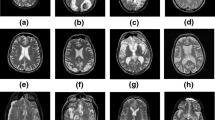Abstract
An automatic, neural network-based approach was applied to segment normal brain compartments and lesions on MR images. Two supervised networks, backpropagation (BPN) and counterpropagation, and two unsupervised networks, Kohonen learning vector quantizer and analog adaptive resonance theory, were trained on registered T2-weighted and proton density images. The classes of interest were background, gray matter, white matter, cerebrospinal fluid, macrocystic encephalomalacia, gliosis, and “unknown.” A comprehensive feature vector was chosen to discriminate these classes. The BPN combined with feature conditioning, multiple discriminant analysis followed by Hotelling transform, produced the most accurate and consistent classification results. Classifications of normal brain compartments were generally in agreement with expert interpretation of the images. Macrocystic encephalomalacia and gliosis were recognized and, except around the periphery, classified in agreement with the clinician's report used to train the neural network.
Similar content being viewed by others
References
Hillman GR, Kent TA, Kaye A, et al (1991) Measurement of brain compartment volumes in MR using composition calculations. J Comput Assist Tomogr 15:640–646
Olsen WL, Longo FM, Mills CM, et al (1988) White matter disease in AIDS: findings at MR imaging. Radiology 169: 445–448
Raff U, Newman FD (1990) Lesion detection in radiologic images using an autoassociative paradigm. Med Phys 17: 926–928
Hall EL, Kruger RP, Dwyer SJ, et al (1971) A survery of preprocessing and feature extraction techniques for radiographic images. IEEE Trans Comput C- 20:1032–1044
Kohn MI, Tanna NK, Herman GT, et al (1991) Analysis of brain and cerebrospinal fluid volumes with MR imaging. Radiology 178:115–122
Lim KO, Pfefferbaum A (1989) Segmentation of MR brain images into cerebrospinal fluid spaces, white and gray matter. J Comput Assist Tomogr 13:588–593
Raya SP (199) Low-level segmentation of 3-D magnetic resonance brain images-a rule-based system. IEEE Trans Med Imaging 9:327–337
Amartur SC, Piraino D, Takefuji Y (1992) Optimization neural networks for the segmentation of magnetic resonance images. IEEE Trans Med Imaging 11:215–220
Clarke LP, Velthuizen RP, Phuphanich S, et al (1993) MRI: stability of three supervised segmentation techniques. Magn Reson Imaging 11:95–106
Hall LO, Bensaid AM, Clarke LP, et al (1992) A comparison of neural network and fuzzy clustering techniques in segmenting magnetic resonance images of the brain. IEEE Trans Neural Networks 3:672–682
Chimowitz MI, Estes ML, Furlan AJ, et al (1992) Further observations on the pathology of subcortical lesions identified on magnetic resonance imaging. Arch Neurol 49:747–752
Just M, Thelen M (1988) Tissue characterization with T1, T2 and proton density values: result in 160 patients with brain tumors. Radiology 169:770–785
Parsons T (1987) Voice and speech processing. McGraw-Hill, New York
Duda RO, Hart PE (1973) Pattern classification and scene analysis. Wiley, New York
Tou JT, Gonzalez RC (1974) Pattern recognition principles. Addison-Wesley, Boston
Gonzalez RC, Wintz P (1989) Digital image processing. Addison-Wesley, Boston
Jain AK (1989) Fundamentals of digital image processing. Prentice Hall, London
Freeman AF, Skapura DM (1991) Neural networks: algorithms, applications, and programming techniques. Addison-Wesley, Boston
Blum A (1991) Neural networks in C++. Wiley, New York
Korn GA (1991) Neural network experiments on personal computers and workstations. MIT Press, Cambridge
Wasserman PD (1989) Neural computing theory and practice. Van Nostrand Reinhold, New York
Tveter DR (1991) Fast-back propagation (computer software)
Hecht-Nielsen R (1987) Counterpropagation networks. Appl Optics 26:4979–4984
Carpenter GA, Grossberg S (1987) ART2: self-organization of stable category recognition codes for analog input patterns. Appl Optics 26:4919–4930
Huang SC, Huang YF (1991) Bounds on the number of hidden neurons in multilayer perceptrons. IEEE Trans Neural Networks 2:47–55
Mirchandani G (1989) On hidden nodes for neural nets. IEEE Trans Circ Syst 36:661–664
Vannier MW, Butterfield RL, Rickman DL, et al (1987) Multispectral magnetic resonance image analysis. CRC Crit Rev Biomed Eng 15:117–144
Author information
Authors and Affiliations
Rights and permissions
About this article
Cite this article
Kischell, E.R., Kehtarnavaz, N., Hillman, G.R. et al. Classification of brain compartments and head injury lesions by neural networks applied to MRI. Neuroradiology 37, 535–541 (1995). https://doi.org/10.1007/BF00593713
Received:
Accepted:
Issue Date:
DOI: https://doi.org/10.1007/BF00593713




